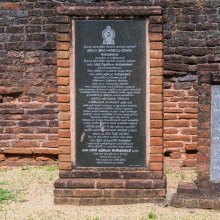Shrimat, Śrīmat: 10 definitions
Introduction:
Shrimat means something in Hinduism, Sanskrit, Jainism, Prakrit, Marathi, Tamil. If you want to know the exact meaning, history, etymology or English translation of this term then check out the descriptions on this page. Add your comment or reference to a book if you want to contribute to this summary article.
The Sanskrit term Śrīmat can be transliterated into English as Srimat or Shrimat, using the IAST transliteration scheme (?).
Images (photo gallery)
In Hinduism
Ayurveda (science of life)
Source: gurumukhi.ru: Ayurveda glossary of termsŚrīmat (श्रीमत्):—Dazzling appearance

Āyurveda (आयुर्वेद, ayurveda) is a branch of Indian science dealing with medicine, herbalism, taxology, anatomy, surgery, alchemy and related topics. Traditional practice of Āyurveda in ancient India dates back to at least the first millenium BC. Literature is commonly written in Sanskrit using various poetic metres.
Shaktism (Shakta philosophy)
Source: Google Books: Manthanabhairavatantram1) Śrīmat (श्रीमत्) refers to “glory”, according to the Manthānabhairavatantra, a vast sprawling work that belongs to a corpus of Tantric texts concerned with the worship of the goddess Kubjikā.—Accordingly, “Above [Śiva] is the tranquil (energy called) Śivā. Subtle, she is (the goddess) Vakrikā of the Abyss (kandara) (of the Void) in the supreme (state). O Kujeśvara, the glory (śrī) within that is the glory of liberation. The (blissful) vibration of the Command (ājñāghūrmi) is (thus) attained in the (supreme) faultless and indubitable (reality). If he desires liberation, the one who possesses (this) glory (śrīmat) should abide on that plane. [...]”.
2) Śrīmat (श्रीमत्) refers to “one who is well-behaved”, according to the Manthānabhairavatantra, a vast sprawling work that belongs to a corpus of Tantric texts concerned with the worship of the goddess Kubjikā.—Accordingly, while describing the signs of one who is a Siddha: “His heart is uplifted and his nose and the rest (of his face) is well balanced. The sign of one who is well accomplished is that he is well behaved [i.e., śrīmat] and he produces abundance. [...] One who is such and is equal in pleasure and pain is part of the Siddha lineage”.

Shakta (शाक्त, śākta) or Shaktism (śāktism) represents a tradition of Hinduism where the Goddess (Devi) is revered and worshipped. Shakta literature includes a range of scriptures, including various Agamas and Tantras, although its roots may be traced back to the Vedas.
In Jainism
General definition (in Jainism)
Source: The University of Sydney: A study of the Twelve ReflectionsŚrīmat (श्रीमत्) refers to the “venerable (omniscient one)”, according to the 11th century Jñānārṇava, a treatise on Jain Yoga in roughly 2200 Sanskrit verses composed by Śubhacandra.—Accordingly, “The doctrine freely bestows the power of the venerable omniscient one (śrīmat-sarvajña-vaibhava) which is furnished with the great eminences [and] is the great abode of the auspicious [events]. It goes along with [sentient beings to the other world], then it protects, produces benefit always [and], having saved [them] from the mire of life it sets [them] on the pure path [of liberation]”.

Jainism is an Indian religion of Dharma whose doctrine revolves around harmlessness (ahimsa) towards every living being. The two major branches (Digambara and Svetambara) of Jainism stimulate self-control (or, shramana, ‘self-reliance’) and spiritual development through a path of peace for the soul to progess to the ultimate goal.
Languages of India and abroad
Marathi-English dictionary
Source: DDSA: The Molesworth Marathi and English Dictionaryśrīmat (श्रीमत्).—a S This is the neuter termination of śrīmān and the form from which the word enters into composition. Ex. śrīmannārāyaṇa, śrīmacchaṅkarācārya, śrīmadbhāgavata The exalted or excellent Narayaṇa, Shankaracharya, Bhagwat.
Marathi is an Indo-European language having over 70 million native speakers people in (predominantly) Maharashtra India. Marathi, like many other Indo-Aryan languages, evolved from early forms of Prakrit, which itself is a subset of Sanskrit, one of the most ancient languages of the world.
Sanskrit dictionary
Source: DDSA: The practical Sanskrit-English dictionaryŚrīmat (श्रीमत्).—a.
1) Wealthy, rich.
2) Happy, fortunate, prosperous, thriving.
3) Beautiful, pleasing; श्रियः पतिः श्रीमति शासितुं जगत् (śriyaḥ patiḥ śrīmati śāsituṃ jagat) Śiśupālavadha 1.1.
4) Famous, celebrated, glorious, dignified; (the word is often used as a respectful affix to celebrated or revered names of persons and things as śrīmadbhāgavata, śrīmatchaṃkarācārya &c.). -m.
1) An epithet of Viṣṇu.
2) Of Kubera.
3) Of Śiva.
4) The Tilaka tree.
5) The Aśvattha tree.
6) A parrot.
7) A bull kept for breeding.
Source: Cologne Digital Sanskrit Dictionaries: Shabda-Sagara Sanskrit-English DictionaryŚrīmat (श्रीमत्).—mfn. (-mān-matī-mat) 1. Wealthy, opulent. 2. Pleasing, beautiful. 3. Prosperous, fortunate, thriving. 4. Famous, illustrious. m. (-mān) 1. A tree, commonly Tila or Tilaka. 2. Vishnu. 3. Kuvera, the god of wealth. 4. Siva. 5. A title applied to any venerable person. E. śrī beauty, &c., matup aff.
Source: Cologne Digital Sanskrit Dictionaries: Aufrecht Catalogus CatalogorumŚrīmat (श्रीमत्) as mentioned in Aufrecht’s Catalogus Catalogorum:—the epithet of a poet to whom one stanza is attributed in the Padyāvalī.
Source: Cologne Digital Sanskrit Dictionaries: Monier-Williams Sanskrit-English Dictionary1) Śrīmat (श्रीमत्):—[=śrī-mat] [from śrī] a mfn. See 1100, [column]2.
2) [=śrī-mat] [from śrī] b mfn. beautiful, charming, lovely, pleasant, splendid, glorious, [Mahābhārata; Kāvya literature] etc.
3) [v.s. ...] possessed of fortune, fortunate, auspicious, wealthy, prosperous, eminent, illustrious, venerable (used, like śrī, as a prefix before the names of eminent persons and celebrated works and sometimes corrupted into śrīmant), of high rank or dignity (m. ‘a great or venerable person’), [Chāndogya-upaniṣad; Mahābhārata; Rāmāyaṇa] etc.
4) [v.s. ...] decorated with the insignia of royalty (as a king), [Varāha-mihira’s Bṛhat-saṃhitā]
5) [v.s. ...] abounding in gold (as Meru), [Bhartṛhari]
6) [v.s. ...] m. Name of Viṣṇu, [cf. Lexicographers, esp. such as amarasiṃha, halāyudha, hemacandra, etc.]
7) [v.s. ...] of Kubera, [cf. Lexicographers, esp. such as amarasiṃha, halāyudha, hemacandra, etc.]
8) [v.s. ...] of Śākya-mitra, [Buddhist literature]
9) [v.s. ...] of a son of Nimi, [Mahābhārata]
10) [v.s. ...] of a poet, [Catalogue(s)]
11) [v.s. ...] Ficus Religiosa, [cf. Lexicographers, esp. such as amarasiṃha, halāyudha, hemacandra, etc.]
12) [v.s. ...] another tree (= tilaka), [cf. Lexicographers, esp. such as amarasiṃha, halāyudha, hemacandra, etc.]
13) [v.s. ...] a parrot, [cf. Lexicographers, esp. such as amarasiṃha, halāyudha, hemacandra, etc.]
14) [v.s. ...] a bull kept for breeding, [cf. Lexicographers, esp. such as amarasiṃha, halāyudha, hemacandra, etc.]
Source: Cologne Digital Sanskrit Dictionaries: Yates Sanskrit-English DictionaryŚrīmat (श्रीमत्):—[(mān-matī-mat) m.] A tree, Tila, Tilaka; Vishnu; Kuvera. a. Fortunate, prosperous, famous.
Sanskrit, also spelled संस्कृतम् (saṃskṛtam), is an ancient language of India commonly seen as the grandmother of the Indo-European language family (even English!). Closely allied with Prakrit and Pali, Sanskrit is more exhaustive in both grammar and terms and has the most extensive collection of literature in the world, greatly surpassing its sister-languages Greek and Latin.
Tamil dictionary
Source: DDSA: University of Madras: Tamil LexiconŚrīmat (ஶ்ரீமத்) noun < śrī-mat.
1. A title prefixed to men’s names; ஆடவர் பெயர்முன் வழங்கும் மரியாதைச்சொல்வகை. [adavar peyarmun vazhangum mariyathaicholvagai.]
2. Auspiciousness; சுபம். [supam.]
3. Prosperity; ஆக்கம். [akkam.]
Tamil is an ancient language of India from the Dravidian family spoken by roughly 250 million people mainly in southern India and Sri Lanka.
See also (Relevant definitions)
Partial matches: Shri, Maat, Mat.
Starts with: Shrimadanandacakra, Shrimadandhri, Shrimadaryavalokiteshvara, Shrimadbhagavata, Shrimadonkara, Shrimanmadana, Shrimata, Shrimati, Shrimatkumbha, Shrimatottara, Shrimatottaratantra, Shrimatsarvajna, Shrimatta, Shrimattama, Shrimatu.
Query error!
Full-text (+15): Ashrimat, Shrimatta, Shrimatkumbha, Shrimadbhagavata, Shrimattama, Shrimadaryavalokiteshvara, Shrimadonkara, Shrimacchatashalakin, Shrimanmadana, Shrimatsarvajna, Shrimadanandacakra, Shrimantan, Shrimadandhri, Shrimaddattopanishad, Shrimannripuri, Cimattu, Cimal, Shrimamanya, Ciman, Shriman.
Relevant text
Search found 46 books and stories containing Shrimat, Śrīmat, Srimat, Shri-mat, Śrī-mat, Sri-mat, Shreemat; (plurals include: Shrimats, Śrīmats, Srimats, mats, Shreemats). You can also click to the full overview containing English textual excerpts. Below are direct links for the most relevant articles:
Notices of Sanskrit Manuscripts (by Rajendralala Mitra)
Brihad Bhagavatamrita (commentary) (by Śrī Śrīmad Bhaktivedānta Nārāyana Gosvāmī Mahārāja)
Verse 2.2.131 < [Chapter 2 - Jñāna (knowledge)]
Verse 1.2.98 < [Chapter 2 - Divya (the celestial plane)]
Verse 2.3.128 < [Chapter 3 - Bhajana (loving service)]
Garga Samhita (English) (by Danavir Goswami)
Verse 5.24.84 < [Chapter 24 - The Killing of the Kola Demon]
Verse 1.4.56 < [Chapter 4 - Description of Questions About the Lord’s Appearance]
Verse 4.10.12 < [Chapter 10 - The Story of the Pulindā Women]
World Journal of Pharmaceutical Research
Correlation of modern kala sharir perspective with contemporary concepts. < [2018: Volume 7, September issue 16]
Mangifera indica linn. < [2022: Volume 11, May issue 5]
Adoption of healthy diet and yoga for prevention and cure of constipation < [2018: Volume 7, September issue 16]
Bhagavad-gita (with Vaishnava commentaries) (by Narayana Gosvami)
Verse 10.41 < [Chapter 10 - Vibhūti-yoga (appreciating the opulences of the Supreme Lord)]
Verse 2.60 < [Chapter 2 - Sāṅkhya-yoga (Yoga through distinguishing the Soul from the Body)]
Verse 18.65 < [Chapter 18 - Mokṣa-yoga (the Yoga of Liberation)]

